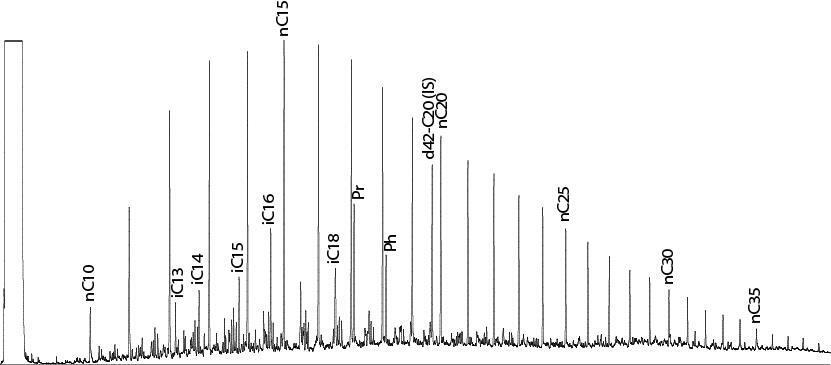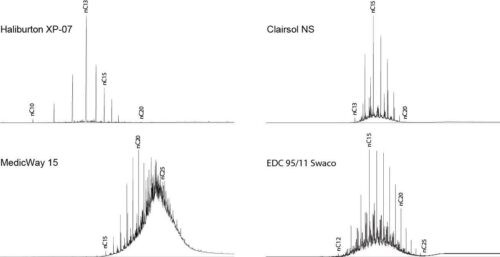GC analyses
Applications
Initial screening of source or reservoir rock extracts and oils is usually performed by GC (with FID detector), which can provide a broad picture of major component distributions and hence some information about:
- source of hydrocarbons
- maturity
- alteration
- contamination by organic components in drilling mud
It also serves as a basis for selection of samples for more detailed analysis by GC-MS (which is more costly and time-consuming, but also more informative). GC analysis can be undertaken on:
- Whole extracts/oils
- Saturates
- Aromatics
Whole oils & bitumen
Oils/condensates are routinely analysed complete, in order that the most volatile components are not depleted by evaporation during isolation of SARA fractions. This analysis is termed whole oil GC (GC-WO), and provides extremely useful information from the distribution of light hydrocarbons.
The C6–C7 range is particularly informative, because virtually all components can be resolved and identified, allowing detailed comparison of samples in correlation studies, as well as evaluation of potential alteration processes upon entrapment, such as biodegradation, water washing, evaporative fractionation and thermal alteration (Thompson 1987, Halpern 1995).

Typical whole-oil gas chromatogram (left) with expanded LHC region (right)
GC analysis of extracted organic matter (GC-EOM) is effectively equivalent to GC-WO, although the most volatile components are inevitably lost during the extraction and concentration procedure. The C10+ range is usually little affected when care is taken not to evaporate extracts to dryness, as performed at APT (e.g. methylnaphthalene data is considered reliable).
The data can be useful for identifying presence of migrated oil in reservoir intervals and in characterising potential source rocks. The influence of organic drilling mud components (e.g. polyglycols and various oil distillation cuts) can also be usefully evaluated. As noted above, such data are valuable in informing selection of samples for further analyses.
A particular application is assessing reservoir segregation using ratios of pairs of neighbouring minor peaks in whole-oil or whole extract chromatograms. Pairs of reasonably resolved peaks from the large number eluting between the n-alkanes and that appear to differ from each other in relative abundance are chosen and ratios calculated for each sample:
Saturates & aromatics
Although useful information can be gained from C10+ components during GC-WO and GC-EOM, GC of the saturates fraction (GCsat) provides cleaner results because it eliminates co-elution problems from aromatics, enabling n-alkanes and major acyclic isoprenoid, such as pristine (Pr) and phytane (Ph) to be determined accurately. Any interference from polyglycols observed during GC-EOM is also removed.

Saturates gas chromatogram for NSO-1 oil standard
Wax analysis
If an oil is suspected of being waxy, the distribution of alkanes above the normal range, i.e. >C40, can be performed using high temperature GC (HT-GC).
Special GC conditions and column are required, enabling detection to >C60. As with all chromatographic analyses, there are trade-offs to be made to optimize analyse for specific types of compounds or volatility ranges. In HT-GC, resolution of lighter hydrocarbons is sacrificed to enable determination of the heaviest components.
Sample requirements
Bearing in mind the potential requirement for any subsequent GC-MS or isotopic analyses, 1 mL of oil is sufficient for replicate analyses. Usually sufficient extracted bitumen is obtained from 100–200 g of unwashed cuttings (minimum of 50 g) or 20–30 g of washed cuttings, core or outcrop (5–10 g minimum).
Less material may be available from reservoir core chips and plugs but, where oil saturation levels are adequate, reasonable results may be obtained.
Analytical procedure
APT analyses follow the NIGOGA guidelines (Weiss et al 2000). There are slight variations in conditions for each of the analysis types in order to optimise resolution over the volatility range of most interest.
Whole oils (GC-WO)
An Agilent 7890 A gas chromatograph is used, fitted with a 50 m x 0.2 mm i.d. HP PONA column (0.5 mm stationary phase film thickness). The temperature programme is: 30°C (10 min. hold) to 60°C (10 min.) at 2°C/min., then to 130°C (0 min.) at 2°C/min., and finally to 320°C (25 min.) at 4°C/min. Trans-hept-2-ene is used as an internal standard.
Extracted bitumen (GC-EOM)
An HP7890 A gas chromatograph is used, fitted with a 30 m x 0.25 mm i.d. CP-Sil-5 CB-MS column (0.25 mm stationary phase film thickness). The temperature programme is 50°C (1 min.) to 320°C (25 min.) at 4°C/min. C20D42 is used as an internal standard.
Aliphatic hydrocarbons (GCsat)
An HP7890 A gas chromatograph is used, fitted with a 30 m x 0.25 mm i.d. CP-Sil-5 CB-MS column (0.25 mm stationary phase film thickness). The temperature programme is 50°C (1 min.) to 320°C (25 min.) at 4°C/min. C20D42 is used as an internal standard.
Aromatic hydrocarbons (GCaro)
An HP7890 A gas chromatograph is used, fitted with a 60 m x 0.25 mm i.d. CP-Sil-5 CB-MS column (0.25 mm stationary phase film thickness). The temperature programme is 50°C (1 min.) to 320°C (25 min.) at 4°C/min. C20D42 is used as an internal standard.
Waxy oil/bitumen (HT-GC)
An HP7890 A gas chromatograph is used, fitted with a 30 m x 0.32 mm i.d. SGE HT-5 column (0.1 mm stationary phase film thickness). The temperature programme is 50°C (1 min.) to 400°C (20 min.) at 5°C/min. C20D42 is used as an internal standard.
Potential problems

The main problem likely to be encountered is oil-based mud contamination. It is more prevalent in cuttings, but can afflict core samples and small volumes of wireline oil samples (DST samples are usually unaffected). The C-number range affected depends upon the formulation used: a narrow around nC13 is typical of XP-07, Clairsol is dominated by the C14–C19, whereas Saraline affects the C8–C26 range.
OBMs are generally saturates rich. Additional lubricants used during coring and core plugging may cause problems; they may include heavier lubricating oils. Mud samples from immediately above and below intervals of particular interest are useful to assess contamination problems, as they allow for recognition of potential additional contamination from oil/bitumen entrained during use of the mud in previous drilling operations.
GC-MS data can often still be used even when OBM contamination is significant because of differences in biomarker composition between oil and OBM, and the restricted C-number range of most OBMs.
References
Halpern H.I. (1995) Development and application of light-hydrocarbon-based star diagrams. Am. Assoc. Pet. Geol. Bull. 79, 801–815.
Peters K.E., Walters C.C., Moldowan J.M. (2005) The biomarker guide vol 2. Cambridge Univ. Press, Cambridge.
Thompson K.F.M. (1987) Fractionated aromatic petroleums and the generation of gas-condensates. Org. Geochem. 11, 573–590.
Weiss H.M., Wilhelms A., Mills N., Scotchmer J., Hall P.B., Lind K., Brekke T. (2000) NIGOGA - The Norwegian Industry Guide to Organic Geochemical Analyses, Edition 4.0. 102pp. Available from http://www.npd.no/global/norsk/5-regelverk/tematiske-veiledninger/geochemical-analysis_e.pdf